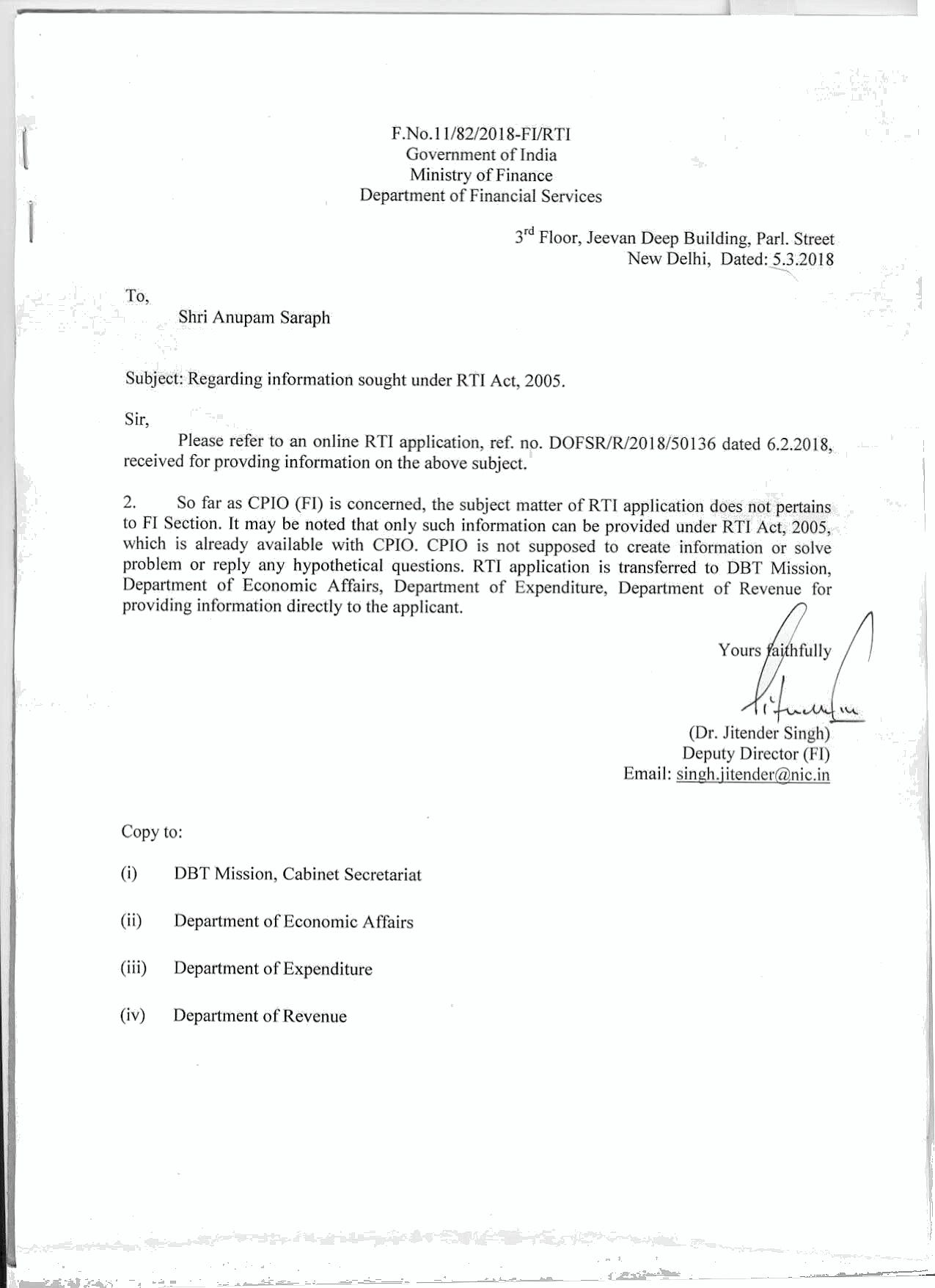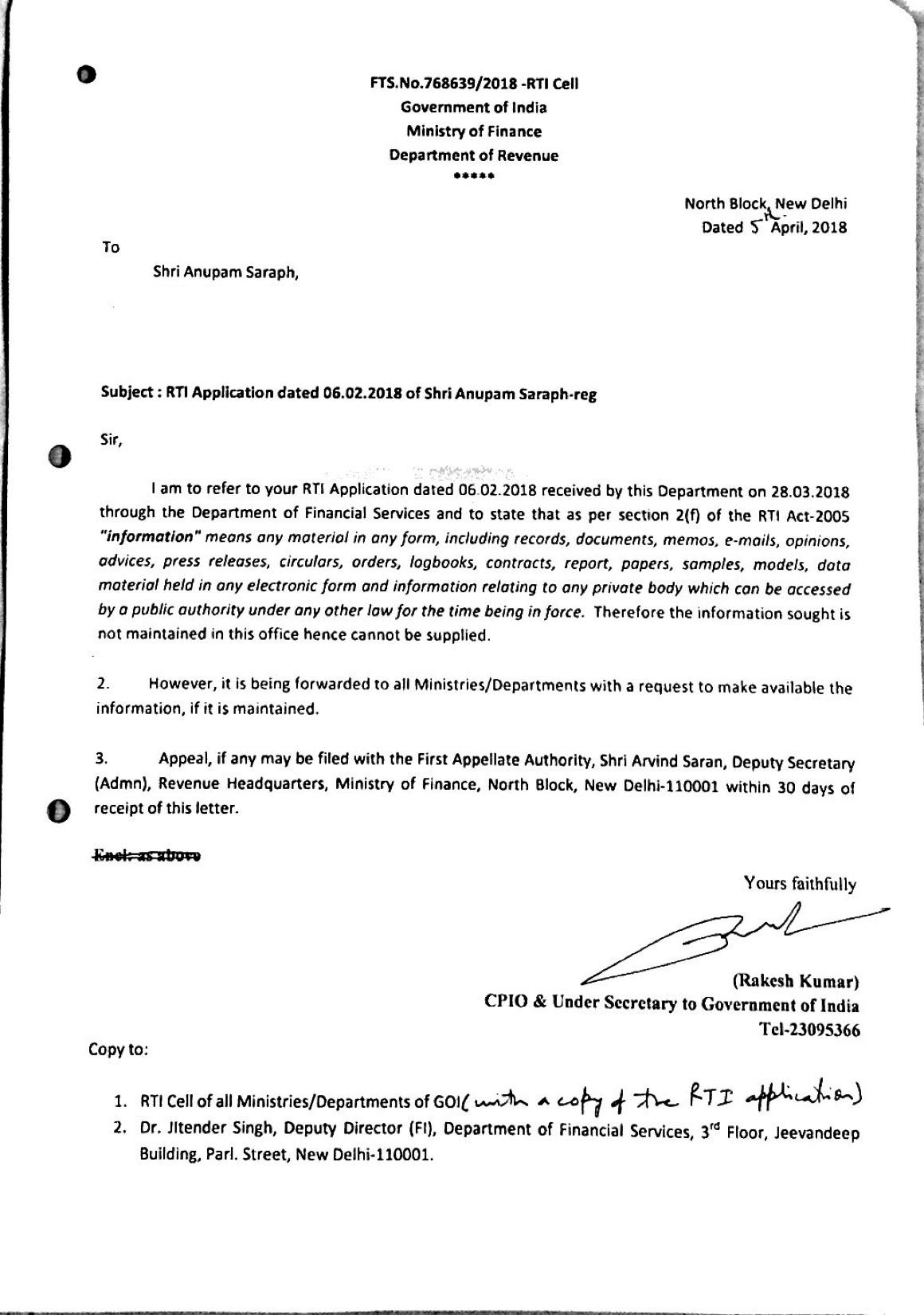Dr. Anupam Saraph is a renowned expert in governance of complex systems and advises governments and businesses across the world. He can be reached @anupamsaraph
Searching for beneficiaries of subsidies and benefits
It turns out that no one in the government knows how beneficiary databases are made, who maintains them and how they are kept free from ghosts and duplicates. It also turns out that no one in the Ministry of Finance is able to trace the flow of funds from the Consolidated Fund of India to the beneficiary. Amazingly no one knows the basis for the decision to shift subsidy and benefitmoney transfers from the Reserve Bank of India’s NEFT to an unauditable payment system run by a non government private company.
The Ministry of Finance Doesn’t Know
The Ministry of Finance indicated, in response to an Right to Information (RTI) query filed with the Ministry on February 6th, 2018, that the subject of beneficiaries or flow of funds from the Consolidated Fund of India to the beneficiaries does not pertain to them or they have no information about it. The various departments of the Finance Ministry indicating that this subject does not pertain to them or they do not have information include: theDepartment of Expenditure, Department of Economic Affairs, Department of Financial Services, the Department of Revenue and Department of Investment and Public Asset Management.
While the Department of Financial Services transferred the RTI to the DBT Mission of the Cabinet Secretariat, Department of Expenditure, Department of Economic Affairs, Department of Financial Services, the Department of Revenue and Department of Investment and Public Asset Management, the Department of Revenue transferred the RTI application to all ministries and departments of the Government of India.

It may be noted that the Department of Financial Services is responsible, among other things, for Financial Inclusion, Social Security, Insurance, Credit Flow to the key sectors of the economy/ farmers/ common man, Pradhan Mantri Jan Dhan Yojana (PMJDY), Pradhan Mantri Suraksha Bima Yojana (PMSBY), Pradhan Mantri Jeevan Jyoti Bima Yojana (PMJJBY), Pradhan Mantri Mudra Yojana (PMMY), Atal Pension Yojana (APY), Pradhan Mantri Vaya Vandana Yojana (PMVVY) and the Stand Up India Scheme.

The failure of the Ministry of Finance to shed light on beneficiaries of subsidies and benefits, the steps to transfer money from the Consolidated Fund of India to beneficiaries and the basis for decision to switch to Aadhaar payments from the RBI run NEFT/RTGS comes as a shock.
The Finance Minster’s Claims
In paragraph 100 of the Budget Speech delivered on February 29, 2016 by the Finance Minister, Arun Jaitley. Mr. Jaitley, had stated that “critical component of minimum Government and maximum governance is to ensure targeted disbursement of Government subsidies and financial assistance to the actual beneficiaries. Public money should reach the poor and the deserving without any leakage.” He added that a “we will introduce a bill for Targeted Delivery of Financial and Other Subsidies, Benefits and Services by using the Aadhar framework” and “A social security platform will be developed using Aadhar to accurately target beneficiaries.”
It is inconceivable how the Finance Ministry could have promised targeted disbursement of Government subsidies and financial assistance to the actual beneficiaries or that money reach the poor and the deserving without any leakage without any information about who beneficiaries are or where leakage is happening.
In order to accomplish the ambitious goal of accurately targeting beneficiaries the government would need to have information about:
- Procedures of law that define beneficiaries of government subsidies and financial assistance.
- The databases of beneficiaries that have been created using these procedures.
- Procedures to identify duplicates and ghosts in the beneficiary databases.
- The audits and studies that show how fake beneficiaries have been added to beneficiary databases.
Neither the Ministry of Finance nor any government ministry or department have been able to provide any information about the laws, rules and procedures that create any beneficiary databases, the existence of such databases, or about procedures or algorithms that provide them an ability to distinguish genuine from duplicate and ghost beneficiaries. Neither have not been able to provide a single audit report or study that shows how fake beneficiaries have been added to beneficiary databases. Neither the Ministry of Finance nor any government ministry or department have been able to provide any indication of the steps in the flow of funds from the Consolidated Fund of India to the beneficiaries in 2008 or in 2018.
From its RTI response it is evident that the Ministry of Finance and the government ministries and departments have no clue about who the beneficiaries of various government subsidies and benefits really are. It is also clear that they haven’t the any idea of how to identify them.
In order to accomplish its goal that public money, transferred by way of cash to a beneficiary, reach the poor and the deserving without any leakage, the government would need to ensure:
- A clear understanding of the steps in the flow of funds from the Consolidated Fund of India to the beneficiaries.
- An auditable payment system for direct transfers to bank accounts that have been opened with time tested KYC guidelines of the Reserve Bank of India (RBI).
Neither the Ministry of Finance nor any other government or department have been able to trace the steps involved in making money transfers from the Consolidated Fund of India to the hands of beneficiaries. Furthermore neither have been able to indicate the basis for the decision to transfer benefits and subsidies through an Aadhaar Based Payment System run by a non government private company, the National Payments Corporation of India (NPCI), in place of the traditional National Electronic Funds Transfer (NEFT) run by the RBI.
According to Nandan Nilekani, former Chairman of Unique Identification Authority of India (UIDAI), that designed the Aadhaar number as an identifier for demographic and biometric data submitted to it, and current Advisor to NPCI, the non government company whose Aadhaar Based Payment System is being used to do direct benefit transfers, over Rs. 95,000 crores were transferred using the Aadhaar Pay of NPCI in the last financial year alone. Neither the UIDAI, nor the Ministry of Finance has certified that this money has been transferred to real and genuine beneficiaries. Neither the recipients database nor the money transfers have been audited and verified by the CAG.
The Minister’s Empty Solution
In response to previous RTI questions the UIDAI has admitted that it does not certify the biometric or demographic data associated with any Aadhaar number. It has no clue about the number of unique records based on biometric or demographic fields. It doesn’t even know if there was an enrolment operator, belonging to a private agency appointed by one of the 20 Registrars whose enrolments make up most of the Aadhaar numbers, in the 600,000 villages, 5,000 towns and cities, or even the 707 districts where enrolment allegedly happened. It has no information about the original documents of proof of identity, address or birth used to capture the demographic data for Aadhaar.
The Aadhaar database has never been verified or audited. This would mean that there is no basis to replace existing Know Your Customer (KYC) with Aadhaar without introducing duplicates and ghosts and corrupting the existing databases of customers and beneficiaries. This also means that there is no basis to argue that money transferred using Aadhaar is not leaking to duplicate or ghost beneficiaries and becoming untraceable.
In another RTI response the UIDAI has stated unambiguously that it takes no responsibility for the use of Aadhaar. It cannot recognise the use, or the absence of use, of Aadhaar in any business process. Neither can it certify the beginning, progress or completion of the business process. Nor can it certify the individuals in the business process are real persons or if they are genuine beneficiaries. It takes no responsibility to any business process.
The UIDAI has also admitted that it doesn’t identify anyone. It merely authenticates the biometric or demographic data associated with an Aadhaar number. Unlike identification, authentication doesn’t require transacting parties to be liable for identifying each other, and for the transaction, before initiating any transaction. This means that the use of Aadhaar banking for transferring any funds from the Consolidated Fund of India is equivalent to moving it into a black hole.

It is evident that using Aadhaar for KYC or delivery of subsidy, benefits and services exposes every institution to transactions that are fake, or with ghosts, duplicates, as well as unidentifiable and untraceable parties. It exposes the institutions to destroying their own customer and citizen databases making it impossible to distinguish genuine from fake records. It enables cyberlaundering. The Minister’s promise of “a social security platform will be developed using Aadhar to accurately target beneficiaries” is at best ignorant of both the problem and the solution.
It is essential, therefore, that the Comptroller and Auditor General of Indiaundertake a financial, compliance and performance audit of the Government, based on the questions the Ministry of Finance and other Ministries and Departments have been unable to answer.
Here’s the List of Questions asked to the Ministry of Finance under RTI filed on 6th February 2018
- Full citation of all laws defining beneficiaries in each government benefit or subsidies to be transferred along with full citations of rules or regulations to identify the beneficiaries.
- Directory of officers who are responsible for maintaining beneficiary databases with the names of officers, name of beneficiary database maintained, number of beneficiaries in each database, and the annual disbursement to each database, from 2005 to date.
- District wise numbers of fake beneficiaries in each beneficiary database.
- Directory of officers who are responsible for algorithms, procedures, processes or implementation of separation of fake beneficiaries from genuine people.
- Full citation of laws defining a fake beneficiary.
- The full details of algorithms, procedures, processes developed to identify fake beneficiaries in each beneficiary database.
- Copies of audits and studies that show how fake beneficiaries have been added to beneficiary databases.
- List of databases where fake beneficiaries have been found with explanation about action taken against each official maintaining the database.
- Copy of file noting that traces the decision to seek alternate to NEFT/RTGS to transfer benefits and subsidies.
- Steps or schematic flow of funds from the Consolidated Fund of India to the beneficiaries in 2008 and in 2018.
